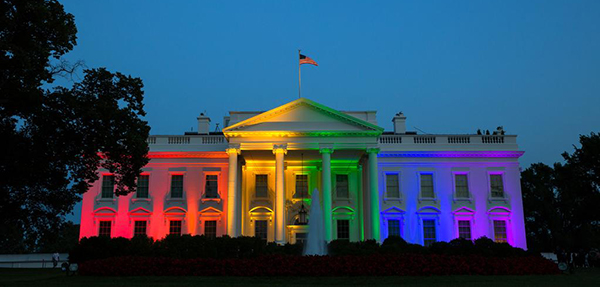
Existem duas tendências divergentes ativamente em ação globalmente hoje. Exemplos de cada tendência foram vistos em junho 26. Naquele dia, vimos três ataques terroristas e o funeral de uma das nove vítimas de um tiroteio em uma igreja na Carolina do Sul. Naquele mesmo dia, os EUA. A Suprema Corte emitiu uma decisão sobre direitos iguais no casamento.
Por um lado, você vê a intolerância do extremismo ideológico que afeta aqueles que se sentem isolados, insatisfeitos ou moralmente superiores - sejam militantes do ISIS, supremacistas brancos ou outros. Os EUA. O Departamento de Estado agora identifica mais de 200 grupos de extremismo violento em todo o mundo.
Por outro lado, estamos caminhando em direção a uma Era de Inclusão.
Os EUA. o Supremo Tribunal recente decisão histórica sobre igualdade no casamento demonstra que uma transformação na aceitação social dos direitos LGBT ganhou força nos Estados Unidos a uma velocidade que surpreendeu muitos. Além disso, a eleição de um presidente negro e de várias candidatas femininas de ambos os partidos para o 2016 eleições reforçam esta mudança. Como Martin Luther King Jr.. disse, “O arco do universo moral é longo, mas se inclina para a justiça.”
Esta promoção da inclusão não se limita aos Estados Unidos. Em maio, Irlanda, um dos países mais católicos e tradicionais do mundo, ingressou 19 outros países para liderar o caminho na promoção da igualdade no casamento e da inclusão para indivíduos LGBT.
Além disso, uma reação cultural a símbolos percebidos por muitos como intolerantes, como a bandeira confederada, recentemente varreu os Estados Unidos. Num testemunho da fé e do perdão demonstrados pelos paroquianos de uma igreja negra em Charleston, SC, que viu nove dos seus fiéis foram brutalmente assassinados por um homem que defende o ódio racial, a sociedade começou a reavaliar a tolerância a esses símbolos.
Embora alguns possam dizer que estes símbolos e crenças também devem ser tolerados como representações dos pontos de vista dos outros, estes emblemas não conseguem passar no teste de inclusão devido à sua associação histórica com a divisão racial e o ódio.
Obviamente, há um longo caminho a percorrer antes que os EUA. ou outros países são verdadeiramente tolerantes e respeitadores das questões raciais, gênero, diferenças religiosas e culturais, mas o arco da história está definitivamente começando a se curvar em direção à inclusão e à justiça social.
Inclusão e desenvolvimento global
Seja com sucesso transições políticas de um presidente cristão para um presidente muçulmano na Nigéria, ou o aumento aceitação da educação das meninas nos países em desenvolvimento, uma maior inclusão pode levar a uma mudança cultural em direção à tolerância e à construção da paz. Isto pode subsequentemente levar a sociedades mais prósperas.
Na verdade, inclusão é um conceito proeminente em muitos dos Objetivos de Desenvolvimento Sustentável das Nações Unidas, previsto para ser aprovado em setembro por mais de 200 líderes mundiais como nossos objetivos coletivos para um mundo mais próspero, mundo democrático e saudável.
Esta viragem para a inclusão centra a atenção dos líderes na forma como as vozes e os direitos das mulheres são incluídos nas decisões de desenvolvimento; como as ideias e a energia dos jovens, que agora contabiliza 30 por cento da população global, são levados em conta nas políticas e programas; e como as minorias étnicas e religiosas recebem representação no governo e em outros espaços.
Tolerância e participação mais ampla resultando em maior progresso – esta é a promessa da Era da Inclusão.
Enfrentando os desafios enfrentados pela inclusão
Quando confrontado com a mudança em direção à inclusão, os críticos citarão a relatividade moral e os desafios extremos de acomodar todos os grupos. A Constituição nos EUA. e em muitos países foi desenvolvido para ajudar a proteger os direitos das minorias.
No entanto, a liderança das gerações mais jovens na promoção desta rápida transformação e aceitação da inclusão é uma grande promessa de como podemos não apenas criar, mas também apreciar a diversidade.
Precisamos de envolver de forma mais eficaz os jovens potencialmente insatisfeitos em todo o mundo, que são vulneráveis às mensagens de intolerância e extremismo, não apenas através de esforços nas redes sociais, mas também de intervenções direcionadas.. Essas intervenções podem ser feitas por meio de suas famílias, grupos de pares, educadores, líderes religiosos ou outros.
A exposição ao “outro” quase sempre gera empatia e compreensão. As ligações crescentes no nosso mundo estão a criar caminhos para a paz entre os jovens à medida que se envolvem com os seus vizinhos, concidadãos e pessoas em todo o mundo. Superando a divisão alimentada pelo medo, ódio e injustiça é uma longa jornada, mas parece recentemente, nós aceleramos nosso ritmo.
Quanto mais tivermos sucesso em capacitar os jovens para que avancem em direção a uma maior valorização da inclusão e a um maior sentimento de esperança, será verdadeiramente uma “Era da Inclusão”.
Michael McCabe é associado sênior de treinamento & Capacitação na Creative Associates International.